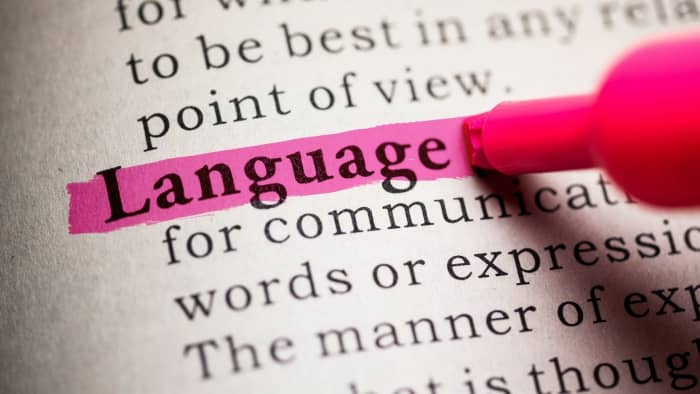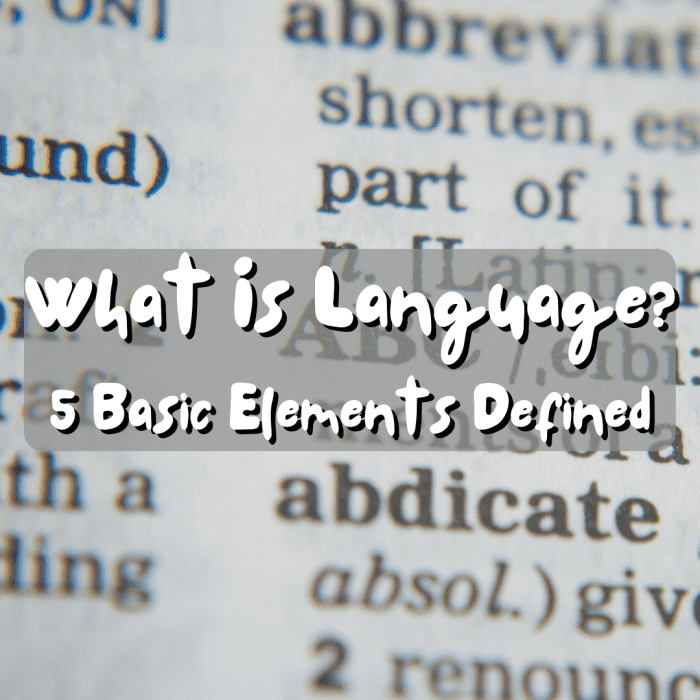What Is Language? The 5 Basic Elements of Language Defined

From babbling to speaking, the mind associates things with words to provide perspective and understanding.
Definition of Language
Language is a form of communication that allows discourse between multiple people that is arbitrary (in words individually), generative (in word placement), and constantly evolving.
Many may dispute this meaning of language because some equate language to communication in general. Where communication can be any action, language must have particular limits placed within its meaning to protect what may constitute a formal language—that is, to distinguish between noises or grunts and communicative utterances in languages.
The lexicon of a language (words used to form a language) allows multiple combinations of words with the possibility of never saying the same group of words the same way!
Language is not a behavior because of its changing nature—its unpredictability. There are slight variations in tone that portray a different meaning for words when uttered that prove processes beyond physical and biochemical reactions affect speech.
Over 170,000 words exist in the English lexicon, which continues to grow as new things need naming! Though the words in the English lexicon are defined and have specific meanings, their nature changes as the generations change; in other words, "cool" means more than the temperature of something or a place.

So, what is language? Read on to discover the 5 basic elements in clear definitions. This article will help you grasp the basics of what exactly a language really is!
Where communication can be any action, language must have particular limits within its meaning to protect what may constitute a proper language.
This article tackles the task of defining 5 of the following fundamental elements of language as clearly as possible:
5 Basic Elements of Language Defined in This Article
- Language is communicative
- Language is arbitrary in nature
- Language is structured
- Language is generative
- Language is dynamic
1. Language Is Communicative
The quality of being communicative, by definition, is a willingness to dispense information. Ancient Roman society preserved records and instructed their progeny in the form and vocabulary, the lexicon of their language. Because of its communicative nature, that ancient language, Latin, existed for centuries, perpetuating generational culture, which sustained that society and continues to provide the rudiments for medical and scientific terminology.
Language is based on random choices by groups of people (nations, even) to communicate needs and wants, a collective system for commerce.
2. Language Is Arbitrary in Nature
One word describing an object may very well be another—such as the word door could as easily have been assigned to a window.
Language is based on random choices by groups of people (nations, even) to communicate needs and wants, a collective system for commerce.
The arbitrary nature of language can be called into question since objects have names based on their initial uses; however, for this brief treatment, it stands as a ruler for language.
Recommended
The evidence that language is arbitrary is overwhelming. The fact that there are hundreds of languages attests that anything can be called anything! Take the word "yes." In English, "yes," means to agree or answer in the affirmative. In Spanish, "si" is to agree or reply in the affirmative. In French, "oui" is to agree or answer in the affirmative. In Xhosa, it is "ewe." Depending on what language a person uses, what English people call "yes" could be any sound.
"Yes," in Klingon it is "HIja." Even fictional languages must meet the five criteria to appear believable!
Arbitrariness as a Property of Language
3. Language Is Structured
There is a pattern of organization in a given language that takes an identifiable shape. The patterns are familiar enough to be identifiable to all other users of that language. Language has basic building blocks that set it aside from other forms of communication.
It would be difficult to build a house without a blueprint. Even if there is no written blueprint, there is a mental template to reference so that others can fashion something similar to the first house. In other words, for those out there thinking that they can build a house without directions, it is not so. The directions are mental and/or physical.
Even languages that have no written form have building blocks in common with written languages. There is a sure way to put words together to make them intelligible to the hearers.
4. Language Is Generative
Language constantly creates new phrases and new structures—it generates more of itself. It is comparable to a living thing that reproduces, changes, and even dies. Even though Latin is a dead tongue, those who use it keep it alive or generative by speaking and writing it.
Language communicates new ideas not possible to convey with gestures and grunts alone. Sign Language is an exception to gesturing because it consists of the five elements of language with no sound.
5. Language Is Dynamic
Language experiences augmentation and refinement (change) as time passes. This change can cause questions in the minds of those who seek to preserve the integrity of certain cultural aspects surrounding a language.
"Dynamic" is a decent way to describe this natural change, this basic aspect of language. "Dynamic," in this case, means that language can evolve and never repeat the exact phrase with the same meaning in the same way without doing so on purpose.
Language gives humanity the ability to be innovative because of its dynamic nature. Cultures, religious systems, and political systems all use language to perpetuate hundreds of dogmas in written form or speech. Language is a very effective tool of persuasion because it is dynamic!
A picture may be worth a thousand words, but a thousand words can clearly express an idea with little room for misunderstanding since a thousand more words await use!
Note
To qualify as a language, all given attributes listed must be present, which questions the forms of signing that exist.
Language Perspective
Culture does influence a person’s view of the world, shaping their ideas and behavior. A person may respond differently depending on how the words leave their mouth because of the way they have to hold their tongue to say words.
The human mind processes language the same regardless of language differences. From babbling to speaking, the mind associates things with words to provide perspective and understanding. Though a language may rise and fall as the ancient Roman society’s language, Latin, did, another will take its place and expand the mind in the same way.
This content is accurate and true to the best of the author’s knowledge and is not meant to substitute for formal and individualized advice from a qualified professional.



